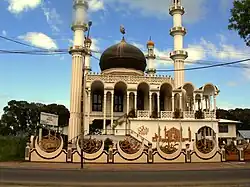Islam in Suriname
According to the official data, the Muslim population of Suriname represents about 13.9 percent of the country's total population as of 2012, which is the highest percentage of Muslims in the Americas. Though the majority belong to the Sunni sect of Islam, there are some Shi'a, and a small population of Ahmadiyyas.
| Islam by country |
|---|
 |
|
|
Some speculate that Muslims first came to Suriname as slaves from West Africa and then were converted to Christianity over time, even though there is little proof for these speculations. The ancestors of the actual Muslim population came to the country as indentured laborers from South Asia and Indonesia, from whom today most Muslims in Suriname are descended.
Because Islam came to Suriname with immigrants from Indonesia (Java) and South Asia (today India, Pakistan and Bangladesh), who brought their local form of Islam to Suriname, it is strongly influenced by these regions. Apart from descent, most Surinamese Muslims also share the same culture and speak the same languages. Suriname has a small number of Afghan Muslims and their native-born children.[1]
East-west divide
The first Javanese Muslims to come to Suriname built their mosques facing west as they did in Java. It was only until contact with Hindustani Muslims in the 1930s that people realized that Mecca is east of Suriname. This created a divide between Muslims who prayed to the east (wong ngadep ngetan) and west (wong ngadep ngulon). The east-worshipping Muslims were more orthodox in their religion, whereas those who worshipped to the west were Javanese and clung more to their traditional Javanese culture.[2]
Demographics

There are 75,053 Muslims in Suriname, according to the 2012 census.[4] This number is up from 66,307 Muslims in 2004. However, the share of Muslims declined from 19.6% to 13.9% in the last half-century. The main reason for the declining share of Muslims in Suriname is the mass conversion of Ahmadi to Christianity in the last years.[5] Between 1971 and 2012 the share of Christianity among ethnic Javanese people grew from 9% to 21% (+12%), while that of Javanese Muslims decreased from 85% to 67% (-18%). The share of Muslims of Indo-Surinamese descent decreased from 17% to 13% in the same period (-4%), mainly because of emigration to the Netherlands and declining fertility rates. The share of Muslims among Maroon people doubled from 0.1% to 0.2%.
| Year [6] | Suriname (population) | Muslim population | Share (%) |
|---|---|---|---|
| 1964 | 324,893 | 63,809 | 19.6% |
| 1971 | 379,607 | 74,170 | 19.5% |
| 1980 | 355,240 | 69,713 | 19.6% |
| 2004 | 492,829 | 66,307 | 13.5% |
| 2012 | 541,638 | 75,053 | 13.9% |
Ethnic groups
Islam is the main religion among Javanese Surinamese people (67%) and the second largest religion among Indo-Surinamese people (13%) and multiracial people (8%).
| Islam by ethnic group as of 2012 | ||||||||||||||||||
|---|---|---|---|---|---|---|---|---|---|---|---|---|---|---|---|---|---|---|
| Ethnic group | Population | Muslims | % | |||||||||||||||
| Javanese Surinamese | 73,975 | 49,533 | 67.0% | |||||||||||||||
| Indo-Surinamese | 148,443 | 18,734 | 12.6% | |||||||||||||||
| Multiracial people | 72,340 | 5,471 | 7.6% | |||||||||||||||
| All Afro-Surinamese | 206,423 | 621 | 0.3% | |||||||||||||||
| Amerindians | 20,344 | 138 | 0.7% | |||||||||||||||
| Chinese Surinamese | 7,885 | 112 | 1.4% | |||||||||||||||
| White Surinamese | 1,665 | 32 | 1.9% | |||||||||||||||
| Others and indefinable | 10,561 | 412 | 3.9% | |||||||||||||||
Geographical distribution

Commewijne District has the highest share of Muslims (mostly Javanese Surinamese), followed by Nickerie District and Wanica District (mostly Indo-Surinamese).
| Share of Muslims by district according to 2004 Census | |
|---|---|
| District | Percent of Muslims |
| Commewijne District | 40.4% |
| Nickerie | 22.5% |
| Wanica | 21.7% |
| Saramacca | 18.8% |
| Para | 11.3% |
| Coronie | 11.0% |
| Paramaribo | 9.4% |
| Marowijne | 6.8% |
| Brokopondo | 0.2% |
| Sipaliwini | 0.1% |
| Suriname | 13.5% |
International
Suriname (since 1996) and Guyana (since 1998) are the only countries in the Americas which are member states of the Organisation of Islamic Cooperation.[7]
Notable Muslims
- Rashied Doekhi, politician
- Paul Somohardjo, politician
See also
References
- The Afghan muslims of Guyana and Suriname
- Hoefte, Rosemarijn (2015). "Locating Mecca: Religious and Political Discord in the Javanese Community in Pre-Independence Suriname". In Yelvington, Kevin A.; Khan, Aisha (eds.). Islam and the Americas. University Press of Florida. pp. 69–91. ISBN 978-0-8130-6013-2.
- "Censusstatistieken 2004" (PDF). Algemeen Bureau voor de Statistiek. Retrieved 25 August 2022.
- https://unstats.un.org/unsd/demographic/sources/census/wphc/Suriname/SUR-Census2012-vol1.pdf
- (in Dutch) MOZAÏEK VAN HET SURINAAMSE VOLK: VOLKSTELLINGEN IN DEMOGRAFISCH, ECONOMISCH EN SOCIAAL PERSPECTIEF Archived 2017-09-02 at the Wayback Machine page 118
- Muslim Population in the Americas: 1950 – 2020 page 7
- Member States of the Organisation of Islamic Cooperation Archived 2013-12-09 at the Wayback Machine
7. https://abdurrahman.org/2014/01/15/mirza-ghulam-ahmad-and-the-qadiyani-sect/
Further reading
- Bal, Ellen; Kathinka Sinha-Kerkhoff (August 2005). "Muslims in Surinam and the Netherlands, and the divided homeland" (PDF). Journal of Muslim Minority Affairs. 25 (2): 193–217. doi:10.1080/13602000500350637. hdl:1871/33761. S2CID 18379751.

.svg.png.webp)